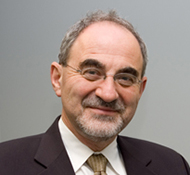Eli Yablonovitch
This article includes a list of general references, but it lacks sufficient corresponding inline citations. (February 2013) |
Eli Yablonovitch | |
|---|---|
 | |
| Born | 15 December 1946 |
| Alma mater | |
| Known for | |
| Awards | IEEE Edison Medal, IEEE "William R. Cherry Award", Oliver E. Buckley Condensed Matter Prize, Isaac Newton Medal, The Rank Prize, Harvey Prize, IEEE Photonics Award, Mountbatten Medal, The R. W. Wood Prize, W. Streifer Scientific Achievement Award, Julius Springer, Adolph Lomb Medal |
| Scientific career | |
| Fields | Physics, Electrical Engineering |
| Institutions | |
| Doctoral advisor | Nicolaas Bloembergen |
Eli Yablonovitch (born 15 December 1946) is an American physicist and engineer who, along with Sajeev John founded the field of photonic crystals in 1987.[1] He and his team were the first to create a 3-dimensional structure that exhibited a full photonic bandgap, which has been named Yablonovite. In addition to pioneering photonic crystals, he was the first to recognize that a strained quantum-well laser has a significantly reduced threshold current compared to its unstrained counterpart. This is now employed in the majority of semiconductor lasers fabricated throughout the world. His seminal paper[2] reporting inhibited spontaneous emission in photonic crystals is among the most highly cited papers in physics and engineering.
Education
Yablonovitch received his B.Sc. in physics from McGill University in 1967. He went on to receive his A.M. degree in applied physics from Harvard University in 1969, and his Ph.D. from Harvard in 1972.[3] During his post-graduate studies, Yablonovitch worked on nonlinear optics with carbon dioxide lasers.[4]
Career
After receiving his Ph.D., Yablonovitch worked at Bell Laboratories. He then became a professor of applied physics at Harvard in 1974. In 1979, he joined Exxon research center to work on photovoltaic research for solar energy.[4] While working at Exxon, Yablonovitch derived the 4 (n squared) factor as the theoretical limit for light trapping in photovoltaics. This is now used worldwide in almost all solar panels.[3]
Yablonovitch joined Bell Communications Research in 1984, and became its director of solid-state physics research in 1991. During his time at Bell Communications, Yablonovitch did his pioneering work on photonic crystals.[1][4]
Yablonovitch became a professor of electrical engineering at UCLA and continued to study and develop photonic crystals and photonic bandgap materials. In July 2007, he joined the Electrical Engineering and Computer Sciences department at UC Berkeley. His research topics include silicon photonics, telecommunications, optical antennas, new applications of photovoltaics, and searching for a low-voltage replacement for the transistor.
Yablonovitch has co-founded multiple companies related to his research interests. In 2000, he co-founded Ethertronics Inc. Ethertronics is a cell phone antenna manufacturer that has, to date, shipped over 1.7 billion antennas.[4]
In 2001, Yablonovitch co-founded Luxtera Inc., a semiconductor company that makes electro‑optical systems using silicon photonics, manufactured with CMOS processes. Luxtera is the first company to market foundry-based silicon photonics.[4][5]
Yablonovitch co-founded Luminescent Inc. in 2002. Luminescent provided sophisticated mathematical optimization for use in photolithography masks. Luminescent was acquired by Synopsys in 2012.[4]
In 2008, Yablonovitch founded Alta Devices Inc. with Harry Atwater. Alta Devices produces thin-film gallium arsenide photovoltaic cells for solar energy. In 2011, Alta set the efficiency world record for single junction solar cells at 28.8%, and dual junction solar cells at 31.5%; all at 1 sun illumination.[3][6]
He is a Fellow of the IEEE, the OSA, and the APS.
He was elected a member of the National Academy of Sciences, the National Academy of Engineering, and the American Academy of Arts and Sciences, and a Foreign Member of the Royal Society of London.[7]
He is a recipient of The IEEE "William R. Cherry Award", the IEEE's highest award in solar cells,[8] The IEEE Edison Medal, The Oliver E. Buckley Condensed Matter Prize, The Isaac Newton Medal, The Rank Prize, The Harvey Prize, The IEEE Photonics Award, The Mountbatten Medal of the British IET, The R. W. Wood Prize, the W. Streifer Scientific Achievement Award, The Julius Springer Prize, and Adolph Lomb Medal.[4][9]
See also
- Alf Adams. Introduced the idea of the Strained Laser at nearly the same time as Yablonovitch.
References
- ^ a b M.Kapoor (2013) Electromagnetic Band Gap Structures, page 58
- ^ Yablonovitch, Eli (1987-05-18). "Inhibited Spontaneous Emission in Solid-State Physics and Electronics". Physical Review Letters. 58 (20): 2059–2062. Bibcode:1987PhRvL..58.2059Y. doi:10.1103/PhysRevLett.58.2059.
- ^ a b c "Eli Yablonovitch | EECS at UC Berkeley". www.eecs.berkeley.edu. Retrieved 2016-01-08.
- ^ a b c d e f g Yablonovitch, Eli. "Curriculum Vitae" (PDF).
- ^ "FIBER OPTICS: Optical transceiver goes where copper cannot". www.laserfocusworld.com. Retrieved 2016-01-08.
- ^ "The Alta Story".
- ^ "New Fellows 2013". Royal Society. Retrieved 30 July 2013.
- ^ "2017 IEEE PVSC-44 | Washington, DC". www.ieee-pvsc.org. Retrieved 2017-03-28.
- ^ "2015 Isaac Newton medal of the Institute of Physics". www.iop.org. Retrieved 2016-01-08.
External links
- 1946 births
- Living people
- American physicists
- Members of the United States National Academy of Sciences
- University of California, Berkeley College of Engineering faculty
- Fellows of the American Academy of Arts and Sciences
- Members of the United States National Academy of Engineering
- Foreign Members of the Royal Society
- Harvard School of Engineering and Applied Sciences alumni
- Jewish physicists
- McGill University alumni
